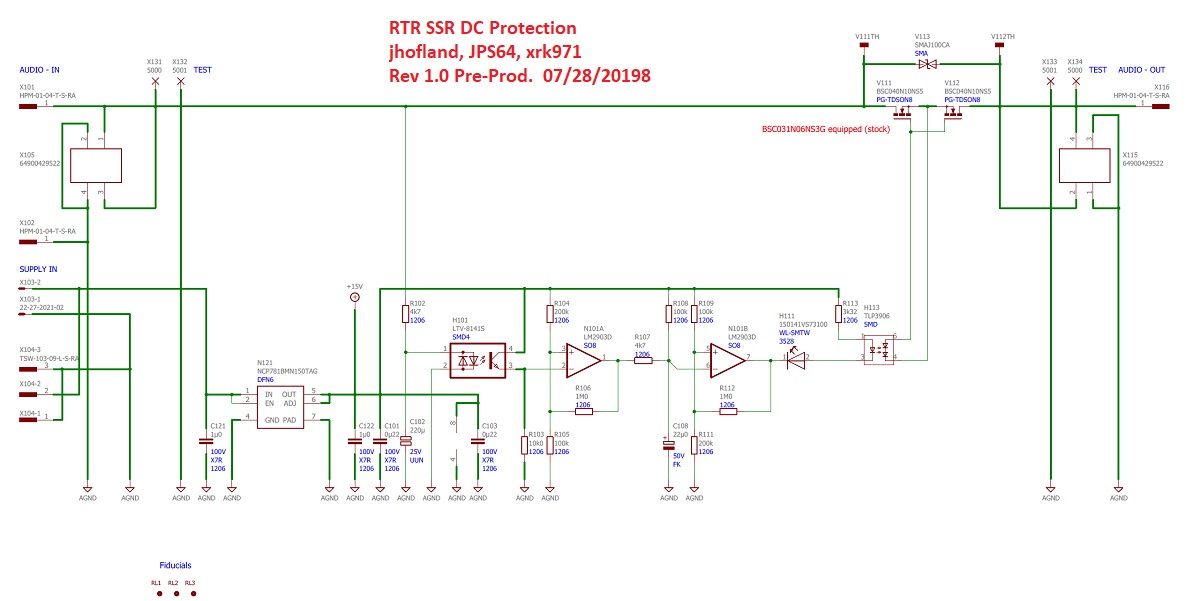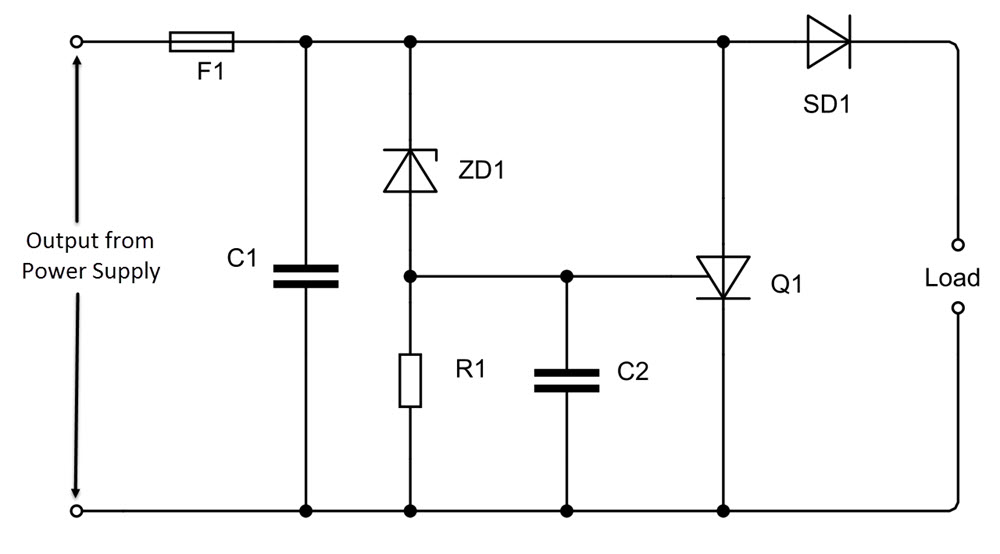Hello Everyone,
I’ve been trying to deploy a circuit to protect my speakers as currently my power amplifier does not have one.
Going through numerous schematics on internet, most of these circuits required some form of vdc to function. However there are a few I found that don’t require additional power.
I’m not electronically trained and would need some help to understand this better. In the end, safety is top priority but and if I can have a circuit that doesn’t require additional power that would make my life so much easier.
Many thanks
I’ve been trying to deploy a circuit to protect my speakers as currently my power amplifier does not have one.
Going through numerous schematics on internet, most of these circuits required some form of vdc to function. However there are a few I found that don’t require additional power.
I’m not electronically trained and would need some help to understand this better. In the end, safety is top priority but and if I can have a circuit that doesn’t require additional power that would make my life so much easier.
Many thanks
Hi,
To give a correct answer, please place a link to the ones which do not need additional Power supply. Personally I tend to use Speaker Protection with EXTRA Power suply.
To give a correct answer, please place a link to the ones which do not need additional Power supply. Personally I tend to use Speaker Protection with EXTRA Power suply.
Hi HPRO,
This is one of them: Loudspeaker Protection Circuit
There’s also one on YouTube YouTube
Thanks
This is one of them: Loudspeaker Protection Circuit
There’s also one on YouTube YouTube
Thanks
They all have an additional power supply ! It is just very unobtrusive. Just search for the 32 Volt battery symbol ! 😉
Regards
Charles
Regards
Charles
@kptseng,
If you look at the circuit you posted, it does, in fact, require power. As shown it takes a 32V supply.
I am not aware of any protection circuits that don't.
If you look at the circuit you posted, it does, in fact, require power. As shown it takes a 32V supply.
I am not aware of any protection circuits that don't.
It would theoretically be possible to feed a protection circuit from the amp output voltage. I once built a tweeter protection for an expensive Audax ring radiator tweeter that switched the tweeter off when there was more than 10 Watts for more than 0.1 seconds and that one was fed from the output signal. Likewise a DC protection circuit could be developed.
Regards
Charles
Regards
Charles
You could harvest power from the audio signal and charge a small LiPo (auto charge and switchover) which then has DC-DC boost to power the speaker protection. These circuits are all off the shelf for small 5v USB charger based stuff. The SSR that Jhofland designed uses 20mA, but that could probably be made way smaller. It wasn’t designed with low current use in mind.
It does work flawlessly and adds no distortion though.

A quick search on audio signal power harvesting turned up this basic concept to harvest power from a headphone jack on a cell phone: a small transformer followed by an active bridge like Lt4320, then send to MCU based charging/5v step up.
http://bioee.ucsd.edu/papers/Effici... Phone Audio Jack for mHealth Peripherals.pdf
The transformer should be chosen to present a relatively high impedance compared to the speaker load.
It does work flawlessly and adds no distortion though.
A quick search on audio signal power harvesting turned up this basic concept to harvest power from a headphone jack on a cell phone: a small transformer followed by an active bridge like Lt4320, then send to MCU based charging/5v step up.
http://bioee.ucsd.edu/papers/Effici... Phone Audio Jack for mHealth Peripherals.pdf
The transformer should be chosen to present a relatively high impedance compared to the speaker load.
Last edited:
There is a "DC offset crowbar circuit" made to protect the speakers, not needing any power supply to work.
Would this crowbar circuit work? Remove C1 and SD1. So choose appropriate R1 and C2 to set time constant longer than say, 100mS (10Hz), and zener at about say, 3v? Pick SCR rated higher than fuse so that fuse blows connection until problem is corrected.


I love crowbar circuits.
Save the speaker (maybe) and short the amp so it most likely needs repair...
Save the speaker (maybe) and short the amp so it most likely needs repair...
That’s why you want the fuse there to blow from the crowbar thus preventing further damage to the amp.
Thank you everyone for your contribution.really appreciate it.
How can I misread the schematic��.........
I’m just concerned that tapping the power from the ones that are driving the amp will affect the SQ, probably going to put a small power supply just for the protection circuit.
It seems like the audio signal will still pass through the relay, so the idea is to get the best audiophile quality relay. Any recommendation (like Omron) from experienced builder?
Cheers
How can I misread the schematic��.........
I’m just concerned that tapping the power from the ones that are driving the amp will affect the SQ, probably going to put a small power supply just for the protection circuit.
It seems like the audio signal will still pass through the relay, so the idea is to get the best audiophile quality relay. Any recommendation (like Omron) from experienced builder?
Cheers
Well, I'm obviously biased on the subject. I strongly prefer not to use an electromechanical relay. They clack, the contacts corrode over time, and on some high current faults the contacts will weld shut defeating the purpose of the protection circuit. Modern high current MOSFETs are arguably more robust and do not affect the sound quality and the drive and detection circuits take less power than their electromechanical counterparts.
If you integrate the circuit into the amp then this is a nice solution. If you want to use a circuit that runs without an external power supply the MOSFET variant is not so practical because you can build the relay version such that it only needs power when it has to shut off and the MOSFET one needs power (or better supply voltage) to turn on.
Regards
Charles
Regards
Charles
I’ll trade anything for safety and sound quality ;-)
After all this is (SQ) is what we DIYers want to achieve isn’t it?
Thanks for letting me know there’s MOSFET speaker protection, there’s already a thread on this topic:
Speaker protect circuit using mosfets
Also I found a some kits on sale but they seems to look quite complicated (maybe I’m wrong)
Guardian-86: High-End Speaker Protection Circuit for use in DIY Amps – Neurochrome
After all this is (SQ) is what we DIYers want to achieve isn’t it?
Thanks for letting me know there’s MOSFET speaker protection, there’s already a thread on this topic:
Speaker protect circuit using mosfets
Also I found a some kits on sale but they seems to look quite complicated (maybe I’m wrong)
Guardian-86: High-End Speaker Protection Circuit for use in DIY Amps – Neurochrome
Last edited:
Just use a large capacitor in series with your speaker.
Safest / lowest cost.
Not sure about sound.
🙂
Patrick
Safest / lowest cost.
Not sure about sound.
🙂
Patrick
- Home
- Loudspeakers
- Multi-Way
- Speaker Protection Circuit - with and without power